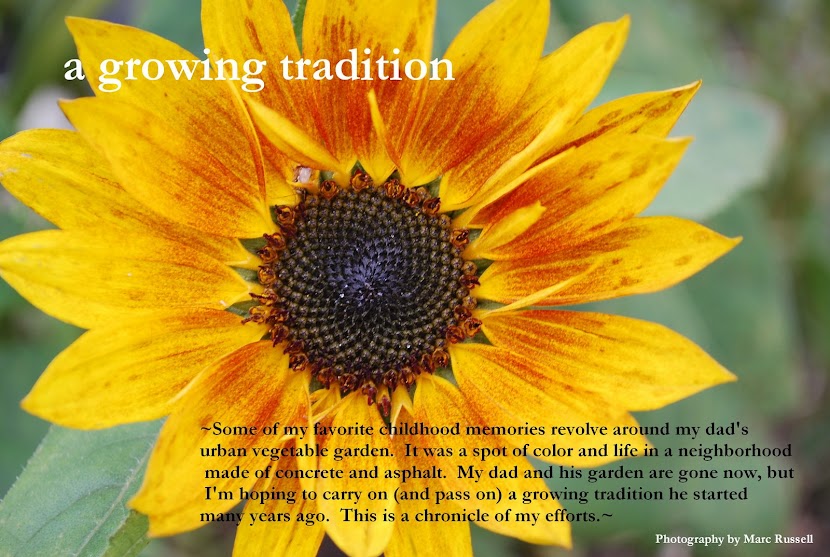I placed the bulk of my seed order for this year back in December and am happy to note that they've all arrived. Now I can focus on drafting my garden plan, updating my sowing dates from last year and sourcing the ingredients for my soil block mix. This year's garden will offer a good mix of new and old. I have a lot of seed left over from last year and from this inventory, I narrowed down which varieties I'll be growing again. The rest will probably be fashioned into
seed bombs (I'm sure there's a vacant lot or two nearby that I could raid.)
Anyway, here are some of the new varieties I'm trying this year as well as some 2010 favorites I had to reorder because I neglected to save seed (awful I know):

Petite Gris de Renne melon - I didn't really care for the Charentais variety I grew summer but decided to give this particular French heirloom a try. The Charentais was very fragrant but I'm hoping that Petite Gris will be sweeter.
Dragon's Tongue beans - I grew these last year. They were very tasty in my opinion and had a texture that held up well when cooked.
Paris Market carrots - Our soil is so heavy that I decided to give this particular variety a try. They have a more spherical shape and I've also read that they can also be grown in pots.
Blacktail Mountain watermelon - I was eying this variety even before I had a garden! Blacktail is an early variety and supposedly does well in cooler climates.
Gold Medal tomato - Seed Savers claims that this is its best tasting bi-colored tomato.
Brandywine (Sudduth's Strain) tomato - I've heard some rather good things about this particular strain. Hopefully it lives up to its reputation!

Here are some varieties I grew last year that I will be growing again: Windsor fava beans, Green Arrow peas, various beets (including Chioggia), Argent corn, American Flag leeks and Contender beans. Argent is a white corn and one of my favorite vegetables grown last year. Sure they take up a good amount of space and are heavy feeders, but for me it's worth it as the taste of fresh corn eaten within minutes of being picked is a true summertime treat.

My main seed order this year was placed with Johnny's. In addition to the Envy soybeans, tatsoi, Imperial Star artichokes and Napoli carrots, all of which I've grown before, here are some factoids about the new varieties I'm trying:
Diamant (pickling) and Tasty Jade (Asian) cucumbers - these varieties will produce fruit even on flowers that are not pollinated. Tasty Jade is supposed to be very crispy like most other Asian varieties.
Hungarian Hot Wax Pepper - I'm looking forward to pickling the yellow, orange and red peppers (depending on when you pick them). I liked the pepperoncini I grew last year (and will grow again this year) but Hungarian Wax has thicker flesh and none of the bitterness.
Regiment spinach - I currently grow a variety called "Space". Regiment is supposed to be just as hardy but has larger leaves.
Athena muskmelon - I'm hedging my bets here. I'm growing this more common muskmelon variety just in case I don't like Petite Gris de Renne.
Sarian strawberry - Sarian is a day-neutral variety of strawberry that is easily started from seed and will produce fruit in the first year. You can grow it as an annual by transplanting the runners in the fall.
Snow Crown Cauliflower - My attempt at growing cauliflower last year proved disastrous. I'm hoping that I'll have much better luck with this very early variety (50 days to maturity).
Alcosa savoy cabbage - I will admit I've never really had an interest in growing cabbage, mainly because I've been under the impression that it can be particularly difficult to grow. Well we shall see. Hopefully I'll be able to keep the slugs and caterpillars under control.
Yellow Sunshine watermelon - A yellow flesh variety, I'm growing it just for fun. I remember being utterly fascinated by yellow-fleshed watermelon when I was a child and begging my dad to buy some. I guess that curiosity never really went away.
San Marzano tomato - I'm growing these because everyone else is. :)
I'm working on my seed-starting schedule now and will post it soon. Our first sowing dates are just weeks away! Can you believe it?
